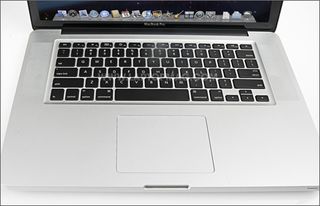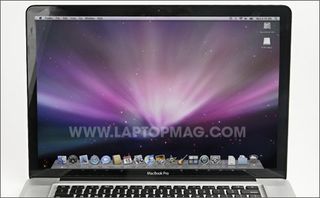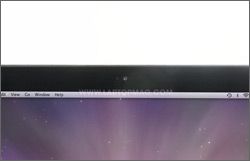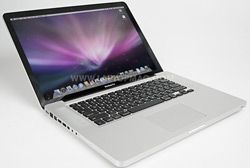Laptop Mag Verdict
Apple's 15-inch powerhouse returns with a sleek new design and dual graphics cards.
Pros
- +
Sleek, durable design
- +
Innovative, buttonless multi-touch trackpad
- +
Powerful discrete graphics
- +
Brilliant, edge-to-edge LED-backlit display
- +
Strong overall performance
Cons
- -
Discrete 9600M graphics not that much faster than 9400M
- -
Switching graphics requires logging out
- -
Only two USB ports
- -
No Blu-ray or mobile broadband option
- -
Still no memory card reader
Why you can trust Laptop Mag
The last time we reviewed Apple's 15-inchMacBook Prowe gave it an Editors' Choice and named it one of our favorite notebooks of 2007, but we pooh-poohed its stale look. A year later, Apple has reinvented the Pro (along with theMacBook), delivering a sturdier, sleeker design, brighter display, and serious graphics punch courtesy of Nvidia. Those with simpler--or more mobile--needs can't go wrong with the more affordable and portable MacBook ($1,299 to $1,599), but the MacBook Pro (starting at $1,999 but $2,499 as configured) is worth it for serious power users with serious cash.
A Whole New MacBook
The newest MacBook Pro borrows some of the design elements introduced with the MacBook Air--namely, an aluminum chassis with rounded edges. Like the Air, it has a shallow black keyboard with separated keys (the last-generation MacBook Pro had a matching metallic keyboard with dense, cushy keys, and was 0.05 inches thicker).
Although the Pro's aluminum surface looks as smooth as the original Air's, it's much sturdier. Thanks to a new manufacturing process, the Pro (and all the other notebooks in the line, save for the entry-level plastic MacBook and the 17-inch Pro, which keeps its old design) is made from one piece of metal, called a unibody, which makes it more resistant to breakage.
Indeed, the MacBook Pro's 14.4 x 9.8 x 0.95-inch body felt solid in our hands, if a tad heavy; at 5.5 pounds it's 0.1 ounces heavier than the last-generation Pro. Nevertheless, the MacBook Pro remains one of the lightest notebooks with a 15.4-inch display.
All Touch, No Buttons
The island keyboard, the likes of which you'll also find on many Sony VAIO notebooks, is backlit in low-light conditions (a feature standard on the 15-inch MacBook Pro but available only on the highest-end MacBook). On the top row you'll find multimedia keys for pausing, stopping, and skipping through movies; these were consistently responsive.

Click to enlarge
The keys are whisper-quiet and comfortable to type on, but for people used to pillowy keys it might take some getting used to. Although both the MacBook and MacBook Pro's island keybords are quiet and comfy, the 13-inch MacBook's keys feel shallower by comparison.
The MacBook Pro builds on the last generation's multi-touch trackpad, which allowed users to manipulate on-screen objects as they would on an iPhone: spread your fingers to zoom in on a Web page, or peruse photos with the swipe of a finger. This glass touchpad is 39 percent larger than on previous MacBooks, and new multi-touch gestures allow users to activate Expos or switch between applications with four fingers (the instruction manual includes illustrated instructions for taking advantage of multi-touch).
Aside from its size, the most notable thing about the touchpad is that it has no buttons. Rather, the entire pad doubles as a button. It's the kind of elegant innovation that made us think, "Why didn't we think of that?" Once you realize that you can press down on the lower end of the pad, using it feels intuitive. Oddly, we found the touch button stiffer on the Pro than on the highest-end MacBook.
The touchpad has just the right amount of resistance. Mastering the art of multi-touch took a few minutes, but once we did, it became addictive. Unfortunately, multi-touch still works only in Apple applications. For instance, we were able to zoom in on a Safari page by spreading two fingers apart, but we could not replicate this in Firefox 3. Mac users have always been able to right-click by tapping with two fingers, but now, users can designate the lower right section of the touchpad for right-clicking.
Display and Optical Drive
Another welcome design change is the MacBook Pro's LED-backlit display with a flat, black bezel. The 15.4-inch, 1440 x 900-pixel screen's brightness, brilliant colors, and seamless, glass-like surface make it the most stunning feature on an already-gorgeous machine. One gripe: the bezel picks up fingerprints easily.
When we watched an episode of Heroes on DVD, we enjoyed bright, accurate colors, as well as versatile viewing angles: we were able to watch comfortably at near-180-degree angles and with the screen tilted far forward. The speakers, which subtly flank the keyboard, delivered loud, lifelike sound.

Click to enlarge
Unfortunately Apple does not offer a Blu-ray option. We can't imagine a better use for that stunning display than watching our favorite movies in high definition, although you can download high-def flicks and TV shows from iTunes.
Ports and Webcam
The Pro has two USB 2.0 ports, a FireWire 800 port, a Mini DisplayPort, a MagSafe power port, an Ethernet jack, headphone and mic ports, and a Kensington lock slot. It also has an ExpressCard/34 slot (but alas, no memory card reader). The FireWire port and ExpressCard slot (great for adding a mobile broadband card) are not available on the smaller, less expensive MacBook line.

Click to enlarge
We wish the Pro had more USB ports, as well as an HDMI port. The Pro does not come with an adapter, but Apple sells a Mini DisplayPort-DVI adapter for $29 (a Mini DisplayPort-HDMI adapter is

Click to enlargenot available at this time).
Like other MacBooks, the new Pro has a 1.3-megapixel iSight camera embedded in the bezel. In both our photo and video captures, it delivered lifelike colors with bright, pleasant lighting. Although the sound in our video captures was spot-on, we noticed slight motion blur as we moved around. To its credit, the camera autofocused quickly as we moved around, and the special-effects package that comes with Photo Booth remains unparalleled (at least, by other notebooks with built-in webcams).
Switchable Graphics
The MacBook Pro comes packed with not one, but two Nvidia graphics cards: a GeForce 9400M with 256MB of shared memory (integrated) and a GeForce 9600M GT with 512MB of dedicated memory (discrete). According to Apple, having two graphics cards gives users the best of both worlds: they can turn on the discrete graphics while gaming or editing high-def videos, and revert back to integrated when they're just Web surfing (or need to conserve battery life).
Switching between graphics options isn't difficult, but it requires one too many steps. You click the Energy Saver Panel in System Preferences and choose either Higher Graphics Performance or Better Battery Life and, when prompted, log out. You must then log back in. We wish Apple and Nvidia would figure out a way to make this switch happen without having to log out and back into the system. The Sony VAIO Z, for example, lets you toggle between Stamina and Speed modes with the flick of a switch.
Graphics Performance
So how good are those discrete graphics? In Cinebench's OpenGL test, a Mac-friendly graphics benchmark, the MacBook Pro scored 5,163. To put that score in context, an older MacBook Pro with an Nvidia GeForce 8600M GPU scored 5,028 (even with the same 4GB of RAM and a 2.6-GHz T8700 CPU). The new MacBook, armed with the same GPU, but 2GB of RAM, scored 4,064. When we switched the MacBook Pro to its integrated 9400M graphics chip, its OpenGL score dropped to 4,666.
In our real-world tests, we took a 2-minute-and-50-second H.264 clip and transcoded it to MPEG-4; with the integrated graphics enabled (9400M), the process took 1 minute and 49 seconds. Using the discrete graphics (9700M GT), the same task took just 7 seconds less.
We then averaged frame-rate scores in eight spots in the first level of Call of Duty 4 with effects set to optimal. Using integrated graphics, the MacBook Pro averaged 20.5 frames per second with the display set to 1440 x 900, which is about 3 fps lower than the MacBook, but that machine was tested with the screen set to 1280 x 800. With its discrete graphics chip activated, the MacBook Pro averaged 29.4 fps.
Using the discrete GPU, in the first room of the frigate we averaged 34 fps. As we moved across the deck of the ship, frame rates averaged 28 fps, which was playable enough. Even when we moved through bullet-ridden, bursting steam pipes, action was still smooth. You won't be able to turn up the eye candy in Call of Duty 4, but it's worth noting that the MacBook Pro can hold its own for relatively new games that aren't too taxing.
Strong Performer
The Pro comes armed with a 2.53-GHz Intel Core 2 Duo T9400 CPU and a generous 4GB of RAM. It scored 3,672 on Geekbench, a performance benchmark, which was just shy of the older, 2.6-GHz MacBook Pro (which scored 3,679). In CineBench, the new Pro scored 2,640 for single CPU performance and 5,536 for multi-CPU performance. The older MacBook Pro with the slightly faster clock speed scored 2,809 and 5,028, respectively, on the same tests.
These unflattering comparisons aside, the new MacBook Pro passed our anecdotal tests with flying colors, booting up in a speedy 39 seconds. It also launched applications quickly, taking 2 seconds to launch iChat and Firefox 3, and 4 seconds to launch iTunes and iPhoto. When it came to multitasking, we had no problem navigating between two windows and five tabs in Firefox, all the while reading e-mails, talking on Google Chat, working in Google Docs, and watching a video on Hulu.com.
If you're into storing movies digitally, you've got a 5,400-rpm, 320GB hard drive at your disposal; it was able to copy a 4.97GB folder of mixed media files in 3 minutes and 54 seconds, a rate of 21.8 MBps--5 MBps faster than the mainstream average.
Wireless Strength
The Wireless-N Airport card performed reliably on our hands-on testing. When we were within 5 feet of our router, Safari took 3 seconds to load CNN.com, 2 seconds for NYTimes.com, 4 seconds for Laptopmag.com, and 1 second for Hulu.com. Using Firefox 3, the Pro loaded these pages in a slightly slower 5, 2, 5, and 3 seconds, respectively.
Unfortunately there's still no integrated mobile broadband option, something we wish was available, particularly now that Gobi offers EV-DO and HSDPA in a software solution (meaning consumers don't have to make a commitment to a particular carrier's hardware at the time of purchase).
Battery Life and Warranty
The Pro lasted 2:47 on a DVD rundown test with the integrated graphics card enabled and with Wi-Fi turned off. That's about 20 minutes less than the previousMacBook Pro, but not bad. The average for mainstream notebooks using the less strenuous LAPTOP Battery Test (continuous Web surfing over Wi-Fi) is 3:25. We will update this review with the LAPTOP Battery Test results in the near future.
Apple covers the MacBook Pro with a one-year parts-and-labor warranty, including 90 days of toll-free, 24/7 phone support (for this much money, we think 90 days is stingy). Upgrading to the three-year AppleCare Protection Plan costs an additional $349.

Click to enlargeVerdict
When it comes to design, performance, and innovation, there's no question that Apple's latest 15-inch MacBook Pro is a stunning notebook. Its looks, dual graphics cards, intuitive multi-touch trackpad, and sturdy design make it one of the best mainstream laptops on the market today. However, we were expecting a bigger jump in performance between the integrated and discrete Nvidia graphics cards.
Plus, $2,499 is a lot to pay for a notebook, especially when there are plenty of Windows machines that offer comparable performance--not to mention Blu-ray, a higher-res display, HDMI, a memory card reader, and an extra USB port--for considerably less. For example, if you don't need switchable graphics and you're willing to carry more weight, you can get all of the above features and the key specs for the higher-end MacBook Pro in the 15.4-inch HP Pavilion dv5t for $1,853 ($646 less than the MacBook Pro). Nevertheless, if you have the money, and you're looking for a powerful notebook you can take almost anywhere, the MacBook Pro is a sound investment. Just be sure to take a good look at the $1,999 version first so that you don't get more features than you need.
On Camera: MacBook Pro
The MacBook Pro is redesigned with a durable unibodychassis, bright LED-backlit display, buttonless multi-touch trackpad, and more. Dana Wollman sits down withthe minimalist machine to walk you through its many pluses and a few of its misses.
[flv:http://blog.laptopmag.com/flvs/MacBookPro.flv 480 360]
Apple MacBook Pro (2008) Specs
| Bluetooth | Bluetooth 2.1+EDR |
| Brand | Apple |
| CPU | 2.53-GHz Intel Core 2 Duo T9400 |
| Card Slots | ExpressCard |
| Company Website | http://www.apple.com |
| Display Size | 15.4 |
| Graphics Card | Nvidia GeForce 9600M GT (Discrete) / Nvidia GeForce 9400M (Integrated) |
| Hard Drive Size | 320GB |
| Hard Drive Speed | 5,400rpm |
| Hard Drive Type | SATA Hard Drive |
| Native Resolution | 1440x900 |
| Operating System | OS X 10.5 Leopard |
| Optical Drive | DVDR DL |
| Optical Drive Speed | 8X |
| Ports (excluding USB) | Mini DisplayPort, Microphone, Headphone, Firewire, Ethernet |
| RAM | 4GB |
| RAM Upgradable to | 4GB |
| Size | 14.4 x 9.8 x 0.95 inches |
| USB Ports | 2 |
| Warranty/Support | One-year limited/90-day 24/7 toll-free phone |
| Weight | 5.5 pounds |
| Wi-Fi | 802.11b/g/n |
